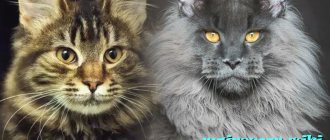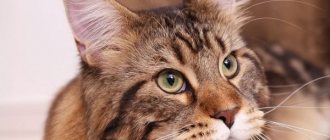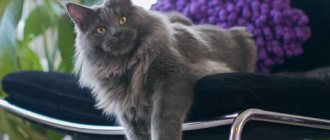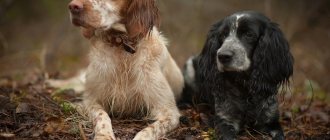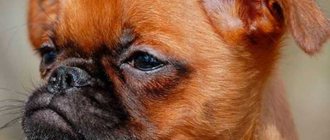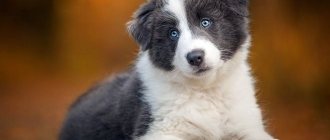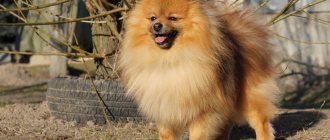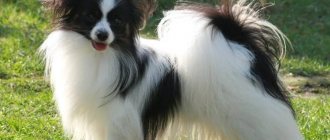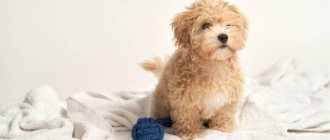Maine Coon cats are gaining popularity. There are many people who want to have such a cat. And demand determines supply, which is expressed both in an increase in the number of the breed and in an increase in the cost of kittens. Few people in the current situation can afford such expenses. Therefore, there is a demand for mixed breeds of this breed. Mixed breeds are not mongrels; they carry the genotype from Maine Coons. It’s worse when they try to sell ordinary cats to buyers under the guise of mestizos—this is obvious deception and fraud. The difference between a purebred and an ordinary cat is very noticeable.
Head shape
Experts say that one of the main distinguishing features of a real Maine Coon is the geometrically correct shape of the lower part of the muzzle. Due to its characteristic symmetry, it is a square. A powerful chin gives the muzzle a brutal and somewhat menacing appearance. Maine Coons are given additional severity by the serious look of their slanted eyes.
This is interesting: Photo of a red Maine Coon
About the origin
Most Maine-Coon mixes are born as a result of random matings. For example, when, having taken his pet with him to the dacha, the owner did not think that his fluffy beauty would probably attract the neighbor’s outbred cat as a bride. However, sometimes interbreed matings are also the result of the activities of unfortunate breeders who decided to see what would happen if they mated a Maine Coon cat, for example, with a British cat.
Interbreeding is a lottery in which it is impossible to predict how genes will fall.
Kittens born from such a mating will most likely turn out to be different from Maine Coons. In addition, there is a high risk that they will be predisposed to many diseases.
Fraud
A conscientious breeder who is proud of his Maine Coons and their offspring will never think of breeding his champion cat with a yard Barsik.
If this happened by accident, for example, due to an oversight, then he will not sell mixed-breed offspring under the guise of purebred kittens.
And he will try to place them in good hands for free.
Intentional interbreeding is carried out by those owners whose cats do not have access to breeding. Such animals will consistently pass on all their shortcomings and vices to their offspring, and it does not matter whether it is from a representative of their own breed or mixed breed. At the same time, the breeder will not just give away mixed-breed kittens, but will try to sell them as early as possible and at a higher price under the guise of purebred Maine Coons.
You should be wary if kittens are sold significantly cheaper than other Maine Coons and, moreover, have not reached 3 - 3.5 months.
In this case, there is a very high risk that they were born as a result of interbreeding and their “breeder” is in a hurry to sell them as quickly as possible, before their external differences with purebred Maine Coon kittens become too obvious.
Body type
Maine Coons are distinguished by their impressive size and weight. The documented body length record is 120 cm. The weight of adult individuals ranges from 8 to 12 kg. The dimensions of kittens from birth are 1.5–2 times greater than those of half-breeds. The weight of Maine Coons is 150–200 g, while ordinary babies weigh no more than 100 g.
If an adult cat weighs less than 7 kg, it is most likely a mixed breed.
Pedigree kittens are also characterized by skeletal development. By 3–4 months, the body and limbs are stretched. Kittens become like “bicycles” and “laces”. They gain weight much later. But even a newborn Maine Coon baby stands out with its massive, wide paws.
Participation in exhibitions, documents
This American cat breed was formed many years ago. The task of breeders is to preserve and improve the gene pool. The participation of a simple cat in breeding negates their efforts.
Due to such factors, owners of hybrids cannot exhibit their pets in the breed ring. However, exhibitions where animals of unknown origin are judged are open to them. There they can show the pet and get a description if the cat is healthy, has a beautiful exterior, and an easy-going character. When the kittens grow up, it will become clear how large they will grow and what their show potential will be.
Useful to read: Features of carriers for Maine Coons
They are allowed into the ring upon reaching 10 months of age. The rules are the same as at regular exhibitions. Separate rings, strict judging. A mongrel pet is prepared with full responsibility: grooming, purchasing accessories. This is a great chance to show your favorite cats to specialists and get a lot of positive emotions from communicating with like-minded people.
Outbred cats are not registered anywhere. They cannot have a pedigree, only a veterinary passport with notes on vaccinations and treatment against worms, which the owner obtains at his own request. Subsequent mating with a coon will still result in his phenotype, and not a true Maine cat.
What to look for when buying a Sphynx
Prices for hairless kittens depend on various factors, including their class. So before buying, decide why you need a pet.
If you are just choosing a domestic cat, pay attention to the pet class. To breed Sphynxes, buy a breed-class kitten
And to participate in exhibitions, choose potential champions who belong to the show class.
Make sure you receive all the documents for the animal:
- A purchase and sale agreement that confirms ownership.
- Veterinary passport, which contains information about vaccinations performed.
- A metric indicating information about the animals is issued by the club. Based on it, you can upon request obtain a pedigree, which contains data on several generations of the cat’s ancestors.
If the listed documents for the Sphynx are not available, first of all take care of obtaining a veterinary passport and make sure that all vaccinations have been completed.
Pay attention to the appearance of the kitten itself. He should be cheerful, active and moderately well-fed
Look at the conditions of his detention and check information about his parents.
Varieties
Throughout the existence of Maine Coons, attempts were made from time to time to cross them with other cats in order to create a new breed. For example, in order for the Siamese color to appear in the breed, they tried to cross them with Siamese cats. But all the hybrid kittens and their descendants did not inherit the desired qualities and were not like their parents, and therefore there was no need to talk about breeding a new breed. What other Maine Coon crosses exist and how do they differ from purebred animals?
Crossed with a Siberian cat
The main advantage of a cross with a Siberian cat is the thick, long and fluffy fur that is common to representatives of both breeds, so such kittens will certainly be fluffy. They can also be larger in size than regular cats. A mixed breed with a Siberian cat will never reach the size of a Maine Coon and the characteristic tufts on his ears will also not appear. In addition, such cats will have a different head shape and a more massive build.
As a rule, mixed breeds with Siberian cats are quite affectionate, although less intelligent.
British mix
This British cross will have traits such as a calm disposition, quick wit, distrust of strangers and neatness. She will be smaller than the Maine Coon, she will have a fairly large and wider muzzle. If this is a kitten from a mating with a British Longhair, then it will grow up to be semi-longhaired. These mestizos are friendly and get along well with children, in addition, they are quite smart and quick-witted , although they are inferior in this regard to purebred cats.
Half-breed with a Norwegian cat
Such a mixed breed will probably be quite large and fluffy, with thick and dense water-repellent fur. He will probably even have small tufts on his ears, typical of Norwegians. The character of such a kitten is a little similar to the character of the Maine Coon: the mestizo will have a well-developed hunting instinct, and he will also be quite affectionate and affectionate towards people.
It should be remembered that even such a kitten may be completely different from either of its parents: it all depends on how the genes are distributed.
A cross between a normal cat
The most unpredictable combination, since an ordinary domestic cat can be the result of a mixture of many breeds. Here there is no need to talk about the similarity of mestizos with Maine Coons both in terms of appearance and character. With a high degree of probability, a mixture of genes from other breeds will turn out to be more dominant and will not allow even one or two of the characteristic breed characteristics of the original breed to appear. Perhaps such mestizos will grow a little larger than ordinary cats. They are also likely to have fairly thick, but somewhat short, fur.
Somalia
It may look like a fox, but it's actually a Somalian! A fast and agile cat, the Somali can jump on the dinner table and ask for seconds!
The Somali cat breed is created from long-haired Abyssinian cats. The body type and markings of the two breeds are similar; however, the length of the Somali fur requires more care than that of the Abyssinian. Unlike most long-haired cats, Somalis have very little extra hair. Their coats generally shed or "blow" once or twice a year, rather than constantly shedding like Persians or other long-haired cats. Somalis, along with the parent Abyssinian breed, have been found to suffer from pyruvate kinase deficiency (PKDef). About 5% of the breed carries the defective gene. There is now a genetic test to identify this recessive disorder in the breed. All breeding stock must be tested to ensure that no affected kittens are born.
Description of the animal
Purebred animals are divided into European and American. Which, in turn, are divided into the Shaw, Brid and Pet classes, distinguished by their large size, rich coat and tassels on the ears. When breeding, Norwegian forest seals are often found, mutations in the form of polydactyly - more than 16 fingers and Dutch rex - coons with curly hair. Maine Coon mixed breeds, like any other breed, are a mixture of the blood of parents of different origins. This can be a purebred and yard cat, or any other purebred with a representative of the animal in question. Such a pet may look different, depending on which genes were passed on from its ancestors.
Types and how to recognize?
In most cases, mestizos are born from random mating; they are not specially bred.
The cat breed in question is distinguished by its large size, large ears with tufts, semi-long hair, a wide chest, strong bones and a long tail. The Maine Coon hybrid has generally accepted types, such as:
- si-kun - a mixture with Siamese;
- Renegade is a cross between a Bengal cat.
A mixed breed cat is undesirable for experienced breeders, most often resulting from accidental mating of animals. The most unpredictable results are obtained from Sphynx cats or yard cats. A half-breed will look different depending on what breed was present in the cross. More details are presented in the table:
| Cats with which Maine Coons were crossed | What do they look like? |
| Kitten from a Persian | Large red kittens with fluffy and soft fur |
| Half-breeds with a Bengal mix | When trying to crossbreed with a Maine Coon, they do not have similarities with both breeds in frequent cases |
| British Scottish Straight mix | The result looks like an ordinary large-sized yard short-haired kitten, not similar to either a British cat or a Maine Coon |
| Hybrid from Scottish Fold | Gives an unpredictable result, in rare cases similar to a fold-eared cat |
| A cross between a Maine Coon and a Siberian cat | Red and tabby cat of outbred appearance |
| Bred with an ordinary cat | A cross between a Maine Coon and a regular cat also looks like yard animals |
| Sphinx mix | Unpredictable result, most often having sphinx ears and fluffy fur |
Wool
Maine Coons have fluffy, thick, but at the same time soft hair. The pants, chest and belly have especially long pile. The undercoat is also silky and delicate. A characteristic detail is long tufts of fur between the toes.
According to the rules, the pedigree of a real Maine Coon is confirmed by a pedigree of at least 4 generations. Conscientious breeders give up kittens at the age of 3 months. If the seller offers younger pets, you should seriously think about purebred.
Mestizos are often not inferior in beauty to purebred individuals, although they are smaller. But if the goal is to acquire a Maine Coon, it is worth taking into account the listed signs and evaluating the kittens according to their presence. If you have any doubts about your own competence, it is better to consult a professional breeder.
(17 votes, average: 3.4 out of 5)
Differences between mestizos and purebred kittens
It is impossible to determine the breed by color, since the coat colors of “Americans” are the same as those of ordinary cats.
If you cross a long-haired Maine Coon with a short-haired cat, the cross will have short hair. And if both parents have long fur, then the cubs will have the same coat. A mestizo may exhibit polydactyly (six-fingered feet), a mutation characteristic of the American breed.
The character of mestizos is impossible to predict. Ordinary cats are more aggressive and independent, while the behavior of the Maine Coon is affectionate and friendly. There is a high probability that the kittens will acquire the character of the outbred parent.
Body dimensions are also unpredictable. But most often large half-breeds are born. As adults, they are slightly smaller than the Maine Coon parent. It is noteworthy that in one litter there can be mixed breeds of different sizes.
You can tell whether a baby is mixed or purebred when he reaches 3 months of age. Signs of mestizo:
- Absence of tufts on the ears, characteristic of a purebred Maine Coon.
- Less strong and heavy paws.
- Less long and strong tail.
- The shape of the muzzle is typical for natural cats, without cheekbones, elongation and the characteristic box chin.
Maine Coon mixed breed: a cross with a regular, Siberian and British cat
The serious look of the Manx raccoon cat has always aroused a wary attitude among people. Even when the animal became a pet, and felinologists thoroughly studied its habits, many consider the character of the Maine Coon to be as harsh as its appearance.
The breed's phenotype is so strong that even a Maine Coon mestizo necessarily submits to its influence and carries the main breeding characteristics: large size, unusual coat and love of water.
How to tell the difference?
The older the kitten, the easier it is to understand whether it is purebred or not.
By about three months, purebred Maine Coon babies acquire tufts on their ears, which are one of the most characteristic features of the breed.
Mixed-breed or outbred kittens usually do not have ear tufts.
In addition, a purebred Maine Coon has wide and strong paws at a very early age with tufts of hair between the toes, and a long and powerful tail.
The head and muzzle of a purebred baby is elongated and wide-cheeked; later it will acquire the so-called “box” shape characteristic of a representative of this breed. And in general, such a kitten looks much larger than its peers. Already at one and a half months he is the same size as a six-month-old young cat of another breed.
The only reliable confirmation of the Maine Coon breed is documents on the origin of the kitten.
Below is a selection of photos of purebred representatives of this breed.
Is it worth buying a half-breed kitten?
How to name a Maine Coon boy or girl
Most owners prefer mestizos not because of their external features, but because the price is lower than for a purebred cat. It is also believed that if the baby has purebred parents, then genes will appear in the kitten. However, in most cases this opinion is erroneous.
Half-breed is an unpredictable pet
It should be understood that a half-breed is not the same thing as a purebred cat. No one can ever guarantee what a kitten will look like when it grows up and what its character will be like. The reason is precisely that purebred Maine Coons are freedom-loving, and even the British gene cannot correct this.
The correct approach to breeding is also important. Irresponsibility can result in a mixed-breed kitten becoming aggressive, sickly, or mentally unstable.
Advantages and disadvantages of a crossbreed
The positive aspect of such half-breeds is their low cost. Most mestizos are friendly and sociable, but there are exceptions. Another advantage is flexibility and affection for a person.
Also, the Maine Coon gene has a positive effect on the intelligence of a cat. Such animals understand and remember commands well and quickly get accustomed to the tray.
As for the disadvantages of mestizo, first of all it is the loss of a thoroughbred pedigree. In this case, there can be no talk of any exhibitions. In addition, if a male and a female of a smaller breed are crossed, there is a risk of death of the mother due to the birth of a large fetus.
Important! If a person nevertheless decides to get a crossbreed, it is worth contacting an experienced breeder to rule out problems with the health and psychological state of the animal.
How to determine the character of a cat depending on their breed?
2 Category: Cat Psychology Wait
British cat character
Thanks to excellent genetic heredity, this breed is distinguished by its good health, in addition, such animals get along well with humans, including other pets that may be in your home. Although such a cat will always feel like a leader. A British cat will under no circumstances impose her company, although she will gratefully accept your affection. In general, the character of this breed is very pleasant, such cats always behave intelligently, they are very curious and sweet. At the same time, cat girls are very shy, and boys are calm. The most interesting thing is, despite the fact that such cats get along normally in society. They can also feel quite comfortable alone.
Personality of the Siamese cat
It is very interesting that such Siamese guts are very distinguished by their obstinate and rather unusual character. A distinctive feature is that this breed is independent, besides, Siamese cats are real hunters, and their hot temperament once again emphasizes their stubbornness. There is also an opinion that Siamese felines can attack their owner at any time, while they are very jealous and insidious, completely unfaithful and disobedient. But this is not at all true, such cats love people very much and their main character trait is a strong attachment to their owner. And if you wrap your pet in warmth and affection, he will pay you back in kind.
Scottish cat character
Despite their appearance and common origin, all Scottish cats are very different from each other. Some of these representatives are affectionate cats, while others, on the contrary, are aggressive. There are also cats that are very active and inquisitive, and there are also those that are very slow and calm. But it is very difficult for such cats to get along with other animals. These pets have a very well developed sense of independence, although raising such animals can be difficult.
Personality of the Bengal cat
Such cats are very similar to wild ones, although on the other hand they easily make contact and are considered very soft animals. By nature, they differ from other breeds in their cunning and intelligence; they are quite mobile and active, even at a more mature age. In addition, this breed simply loves to swim and bask in the water.
Character of Siberian cats
The Siberian cat has a fairly independent character and hunting traits, she has a well-developed instinct, she is affectionate, friendly, active and playful, she will respond with love to all your caresses, but she also has restlessness. This breed can be friends with dogs and get along well with them. The Siberian cat is very smart and intelligent, and by its nature is amenable to learning and training. Therefore, such pets are very smart. Siberian cats do not like to sit on hands and laps, and they very rarely vocalize.
Possible offspring
No significant changes are expected in terms of coat color. Most domestic cats without admixture from other breeds have the colors acceptable in Maine Coon Cats. But genetics suggests unexpected results. Mutations, such as polydactyly, which is common in coons, are likely to affect part of the litter. Coat color and pattern are inherited according to established laws.
Useful to read: How much do Maine Coons cost?
Science knows interesting facts about eye color. Usually it does not depend on the color of the coat, but blue pigment accompanies color-point colors (Siamese cats), and less often white. In practice, if you cross a green-eyed coon with a blue-eyed female, the offspring will most likely take after the father for this trait. This happens because green is dominant to blue. When white kittens are born, the situation may change.
All Maine Coon cats have medium-length fur. If you cross a representative with a smooth cat, the litter will be short-haired. The birth of kittens with long hair is possible if there are two long-haired parents.
Character and behavior are unpredictable in this combination. Street cats are more aggressive by nature, this is dictated by the laws of survival in difficult conditions. Pedigree cats are softer, because purposeful work has been carried out for decades to consolidate behavior that is comfortable for humans.
Weight and body structure are also difficult to calculate, but most half-breeds are distinguished by their impressive dimensions, although they are inferior to their purebred parents. Kittens are born with different characteristics, some are smaller, some are larger.
Metis requires the same careful attention as a purebred animal. A balanced diet, walks, and the love of the owner are mandatory criteria for the happiness of any pet.
Oriental Shorthair
The Oriental Shorthair, known as the "rainbow cat", is an intelligent, social animal that has a very close bond with humans. They are inquisitive, friendly, emotional, demanding and often quite loud. Their purring can be very loud when they are happy.
The Oriental Shorthair is a member of the Siamese family. They can be found in solid colors (white, red, chocolate, cream, ebony, blue, lavender, cinnamon or fawn), smoky (an undercoat of white to any of the above except white), shaded (only the ends of the hair are dyed), partially dyed (red or cream splashes on any of the above), striped (mackerel/striped, tagged, spotted and spotted/classic) and bi-color (any of the above, with white). In total, more than 300 combinations of colors and patterns are possible.
External features of cats
When crossing representatives of different breeds, there is a risk that the offspring will not inherit any desired characteristics. There is a general description of the external parameters of mestizos.
A mixed breed of Maine Coon and Siberian cat resembles a purebred cat in appearance. The colors and shape of the skull are similar. There are almost no external signs of Siberian admixture. At the same time, such mixtures do not grow to large sizes. In addition, such individuals do not have tufts on their ears.
Mixed Maine Coon and Siberian cat
Mixing a Maine Coon with a barn cat leads to the appearance of kittens that resemble a purebred animal in color and strong bones. At the same time, they are distinguished by a less flexible character. In addition, not all the positive qualities of a purebred animal will be passed on to the offspring. In rare cases, kittens have tassels. Such mestizos reach large sizes.
Maine Coon and barn cat mix
Crossing Persians and Maine Coons produces large kittens. They have fluffy fur, often red in color. Externally, the offspring resembles a Persian.
Persian and Maine Coon mix
When representatives of the breed are mixed with a Scottish Fold cat, offspring will appear that are similar in appearance to the mother. Crossing with a Sphynx results in kittens with a fluffy body and erect large ears. If a Briton is involved in the crossing, the offspring will not resemble the purebred parents. The kitten will have medium length fur and a large head.
Crossing with a Norwegian cat allows you to get large kittens covered with thick hair that is water-repellent. Often, such mestizos begin to have tufts on their ears at 3 months.
Mixed Norwegian cat and Maine Coon
General concepts
A mixed breed is a cat from parents of different breeds or without one at all.
In principle, any kitten without documents is called this all over the world. This does not make him worse or better, but the breed cannot be recognized in him. There are conditions that by the exterior at the exhibition you can determine whether you belong to the coon phenotype. There are two main definitions - genotype and phenotype. The first is “internal content,” the set of genes that was passed on from parents. From each of them, kittens receive half a set. Phenotype – external characteristics. It is also passed down from ancestors and depends on combinations of genes. Color, length of the body, limbs, shape of the skull are inherited, like other parameters, but assumptions about the appearance of the future offspring are usually not justified. You can delve into the laws of genetics and calculate what color kittens will be born. Character and temperament will remain a secret until the individual fully matures. The breed was bred naturally. Breeders cultivate those qualities that are characteristic of the Coon:
- Friendliness;
- Equilibrium;
- Flexibility;
- Caution;
- Lack of aggression;
- Loyalty.
When mating with an ordinary representative of the cat family, these features are transformed and sometimes disappear altogether. According to the rules, a real Maine Coon is considered purebred if its ancestors are known in 4 generations. That is, he must have a pedigree with the specified parents, etc.
[ads-pc-1]
Advantages and disadvantages
The main advantage of half-breeds is their moderate cost. And mestizos are also very flexible and friendly. Despite their origin, such pets will be devoted and loyal friends. Another positive quality is the loving and sociable nature of cats.
They can be compared to small children, because they love affection and attention very much, they gladly reciprocate their feelings to their owner.
Developed intelligence allows you to carry out various commands, and easy receptivity to information will help you quickly accustom the kitten to the litter box. Mestizos have strong immunity, they get sick less. In terms of appearance, they are in no way inferior to purebred cats. Their unusual color and fluffy tail can charm anyone. To avoid surprises, before purchasing such a pet, you should carefully study information about its parents.
Disadvantages include the lack of pedigree and the inability to participate in exhibitions.
It is undesirable for mestizos to reproduce, as there is a huge risk of the cat dying during childbirth due to the large size of the kittens.
Japanese Bobtail
The Japanese Bobtail is a breed of domestic cat with an unusual "pointy" tail that resembles that of a rabbit. Short tail is a body type mutation caused by a recessive gene.
Sometimes the Japanese Bobtail may have mismatched eye colors. Regardless of breed, cats with this trait are known as fuzzy-eyed cats. This breed has one iris that is blue and the other yellow. This trait is more common in this breed than most others.
On average, the breed is an active, intelligent cat with a highly human-oriented nature. They are easier to train to perform tricks than most breeds and are more likely to enjoy learning human-mediated activities such as harness and leash walking and playing catch. Considered to be an unusually “talkative” breed, they often communicate vocally with people. Their soft voices are capable of producing almost the entire range of tones, leading to the popular belief that they can sing.
Features and risks of breeding
You should not hope that a mixed-breed kitten will look like a real Maine Coon. Indeed, during interbreeding, the characteristic traits inherent in representatives of a given breed appear extremely rarely, even individually, and never all at once. Even if the resulting kittens are a little larger than babies from a cat of another breed and a little fluffier, they will still be very different from purebred animals.
The amazing character of Maine Coons, which so distinguishes them from ordinary cats, is also, as a rule, not passed on to mixed-breed kittens. In addition, the more breeds are mixed, the greater the risk of genetic diseases or congenital pathologies.
Mating a Maine Coon cat with a representative of another breed is also fraught with the fact that due to the very large size of the kittens, the cat may simply not give birth and die.
Finally, there is a risk that mixed-breed kittens, which have disappointed their new owners because they are different from purebred animals, may end up on the street or in a shelter.
Where do they come from?
It is worth noting that modern veterinarians, dog breeders and felinologists are against unprofessional mating of undocumented breeds and representatives and admission to breeding. This is not because these experts regret the emergence of new species, but because there are more than 60 varieties of cats.
Many of the officially recognized ones are also originally crossbreeds of two breeds, which, as a result of selection, became independent species. This is how the British and Scottish, Munchkin, and Ukrainian Levka breeds were developed.
The work of felinologists to improve these breeds continues to this day.
But it also happens that mixed-breed kittens appear in a family in which they are not familiar with the methods and conditions of breeding. This often happens if animals of the opposite sex are in the same room while in heat. Or the owners let the animals go for a walk during the mating season, which ends with the cat becoming pregnant from an unknown cat.
We invite you to read: this is how different dinosaurs looked like Euparkeria
Of course, such situations are an example of irresponsible animal husbandry, since they pose a threat to both the life of the animal and its health.
Mixed breeds are also obtained from owners who decide to independently experiment with mating between breeds
Mixed breeds are also obtained from owners who have decided to experiment on their own with mating between breeds, which they say has produced unusual and beautiful crosses and offspring.
Conditions and care
Often breeders of mixed breeds believe that if the animals are not purebred, they do not require any specific care and regular visits to the veterinarian.
However, this is not true, because only with high-quality food and regular care will the animal reach its maximum size and not have health problems. After purchasing a kitten, you need to show it to the veterinarian so that he can set a date for sterilization and draw up a vaccination plan.
Considering that mestizos have thick fur, they need to be tamed to combing from an early age. During the shedding period, your pet's fur needs to be combed every day. The rest of the time, the procedure should be performed once a week.
You need to bathe your pet with shampoo and conditioner for long-haired cat breeds. Your pet should be treated regularly against parasites.
Animals can be given premium jelly food, but it is better to feed them natural products. They should not be given milk.
You can include in your pet's diet:
- boiled rabbit and chicken;
- raw beef;
- sour cream;
- cottage cheese;
- boiled vegetables;
- sour cream;
- kefir;
- porridge.
The diet must be balanced, as a lack of nutrients will affect the quality of the coat. You need to regularly wash your pet's eyes with a special solution. This will reduce the risk of infection.
Once a week you should clean your cat's ears and give him a manicure. The animal must have access to special toys designed to remove plaque. Some mestizos reach large sizes, so they require a special tray.
Russian blue
The Russian Blue is a quiet, elegant cat with a silver-blue coat. These cats are known to be very intelligent, curious and calm animals. They were known to play hide and seek and are sensitive to basic human emotions. They enjoy playing with a variety of toys and develop very strong bonds with their loved ones.
Russian Blues are also good with children and other pets. They are known to be quiet and clean animals that are usually kept around strangers unless raised in a very active household. They also love to play with other small pets such as dogs and other cats. Russian Blues have an average life expectancy of about 10-15 years, and they have few health problems, as they generally have few genetic problems and are not susceptible to disease. They are a medium sized cat with an average weight of 8-12 pounds when fully grown. Males will usually be larger than females.
